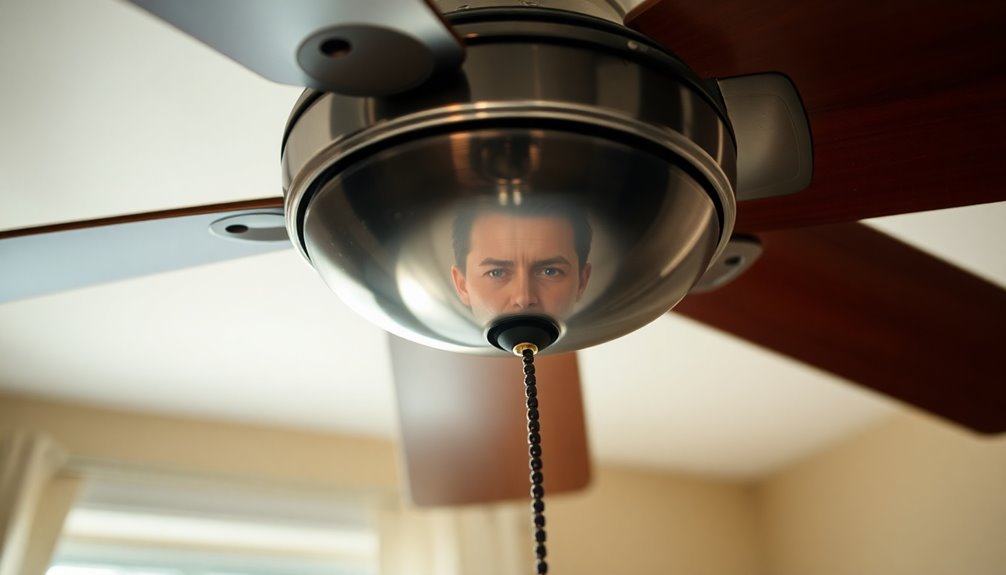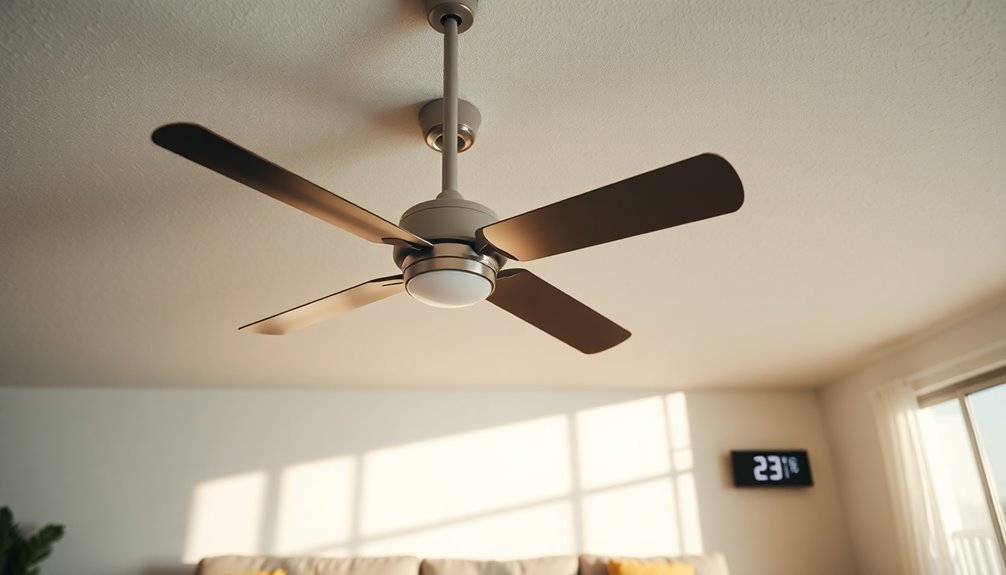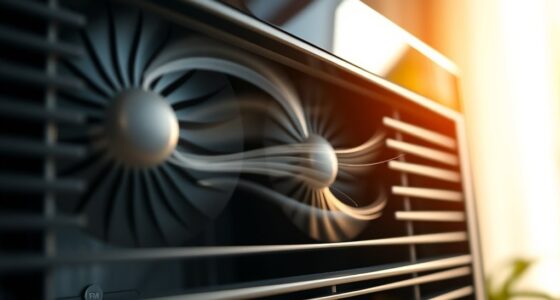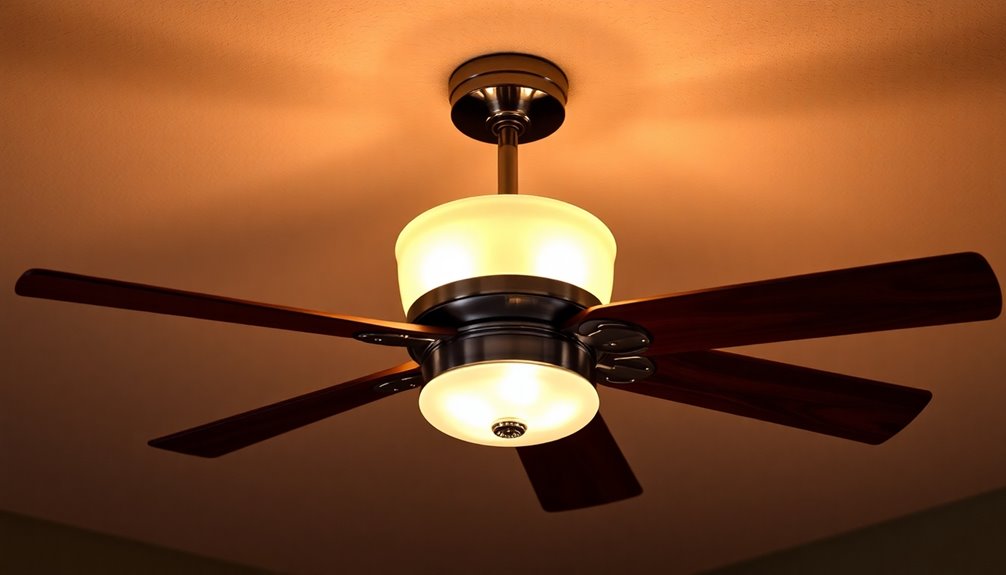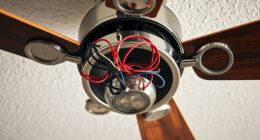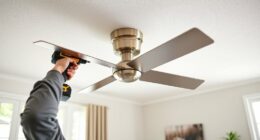Your ceiling fan might not be working due to several common issues. First, check the circuit breaker to guarantee the power is on. Look for loose wiring connections or burnt capacitors, which are essential for the fan's operation. You may also need to inspect the fan blades for any damage or obstructions. If your fan is remote-operated, verify the batteries and pairing. Overheating or electrical surges can cause motor problems, too. To get a better understanding of these issues and how to fix them, you might want to explore further.
Key Takeaways
- Check the circuit breaker to ensure it hasn't tripped and power is active to the ceiling fan.
- Inspect for loose wiring connections that may interrupt the power supply to the fan.
- Test the fan switch and remote control batteries for functionality and proper pairing.
- Look for imbalanced or damaged fan blades, which can cause wobbling and operational issues.
- Assess the motor and capacitor for failure, as these components are essential for fan performance.
Common Causes of Malfunction

When your ceiling fan suddenly stops working, it can be frustrating. Several common causes might be behind the issue.
First, check for loose wiring connections; they can interrupt the power supply to the fan, preventing it from operating. If the wires aren't secure, the fan may not get the energy it needs.
Another potential culprit could be burnt capacitors. These components play an essential role in the fan's motor function, and if they fail, the fan may become unresponsive.
Additionally, imbalanced or damaged fan blades can hinder performance, causing the fan to wobble or stop entirely.
Don't overlook the possibility of voltage fluctuations or other wiring issues. These can lead to insufficient power supply, leaving your fan unable to operate.
Finally, tripped circuit breakers can disrupt power to the fan; checking your breaker panel may reveal the problem.
Troubleshooting Steps

If you've identified some common causes of your ceiling fan's malfunction, it's time to move on to troubleshooting steps that can help you pinpoint the issue.
First, check the circuit breaker to verify the power to your fan is active. Verify that the light switch controlling the fan is in the ON position. If everything seems fine, inspect the fan blades and motor for visible damage or obstructions. Make sure all screws are tightened securely.
Next, test your fan switch for continuity using a multimeter. A faulty switch can disrupt the power flow, preventing your fan from working. If that checks out, examine all wiring connections for loose or damaged parts, as wiring issues are a common cause of ceiling fan malfunctions.
If your fan operates via a remote control, confirm the batteries are functional and that the remote is properly paired with the fan receiver.
Motor and Speed Issues

When your ceiling fan isn't working, motor and speed issues could be the culprit.
You might experience inconsistent speeds or complete failure due to common motor failures, faulty capacitors, or speed control problems.
Let's explore what you can do to troubleshoot these issues and get your fan back up and running.
Common Motor Failures
Ceiling fan motors are crucial components that can experience various failures, leading to frustrating performance issues. One common cause of ceiling fan motor failure is a burnt capacitor. If your capacitor's faulty, the motor won't receive the necessary power to operate, leaving you with a non-functional fan.
Additionally, overheating can occur from prolonged use without adequate maintenance or lubrication of internal components. This overheating often results from worn-out or damaged bearings, which increase friction and can ultimately lead to motor malfunction.
Electrical surges or voltage fluctuations can also wreak havoc on your ceiling fan motor. These issues can damage the internal wiring, causing inconsistent performance or even complete failure. If you find your fan not responding to speed settings, it mightn't just be a control circuit board problem—it could indicate a deeper motor issue.
Regular maintenance and monitoring of your ceiling fan can help prevent these common motor failures. If you notice any signs of overheating or unusual noises, it's important to address these fan issues early to guarantee your ceiling fan continues to operate efficiently.
Speed Control Problems
Motor issues can lead to speed control problems that leave your ceiling fan frustratingly unresponsive. If your fan isn't responding to speed settings, it could be due to faulty capacitors, which may prevent the fan from operating at all speeds.
Worn-out motors often struggle to maintain consistent performance, resulting in either no operation or erratic speeds. A malfunctioning fan switch can further complicate matters, making it impossible to adjust the speed or locking the fan into a single setting.
Additionally, wiring issues like loose connections or damaged wires can disrupt the signal transmission to the motor, leading to speed irregularities. You might notice that the fan fluctuates or fails to respond as expected.
Inconsistent power supply caused by voltage fluctuations can exacerbate these problems, causing your fan to operate erratically or not at all.
To restore proper fan speed control, check the motor housing, inspect your wiring, and test the fan switch. By addressing these issues, you'll be one step closer to enjoying a smoothly operating ceiling fan again.
Capacitor Replacement Guide
Replacing a faulty capacitor can breathe new life into your ceiling fan, restoring its functionality and speed control. A well-functioning capacitor is essential for starting the motor and regulating the fan's speed.
If your fan isn't working properly, follow these steps for a smooth capacitor replacement.
- Turn off the power at the circuit breaker to prevent accidents.
- Remove the fan's housing cover to access the capacitor for inspection.
- Use a multimeter to test the old capacitor for continuity. If it's faulty, get a compatible replacement that matches the voltage and microfarad rating in the manual.
- Carefully connect the wires of the new capacitor according to the original configuration, ensuring all connections are secure.
- Monitor the fan after the replacement for any overheating or unusual noises, which might indicate improper installation.
Lighting Problems

If your ceiling fan's lights aren't working, the first step is to check the bulbs and replace any that are burnt out.
Next, inspect the light socket for any signs of damage and verify the wall switch is functioning properly.
Bulb Replacement Steps
When you notice that your ceiling fan's light isn't working, it's often a simple matter of a burnt-out bulb. Follow these steps to replace it safely and effectively:
- Turn off the power at the circuit breaker to guarantee safety.
- Use a ladder to carefully reach the fan and unscrew the light bulb from the socket. Avoid excessive force that could break the bulb.
- Select the correct wattage and type of bulb as specified by the manufacturer's guidelines to prevent overheating.
- Check the light socket for any signs of damage or burn marks before proceeding.
- Restore power at the circuit breaker and test your ceiling fan to guarantee the new light bulb works.
Socket Inspection Tips
A thorough socket inspection is vital for diagnosing lighting problems with your ceiling fan. Start by examining the light socket for burn marks or any signs of damage. These indicators can reveal wiring issues that may disrupt power flow to the fan.
Next, verify the light bulbs are securely installed and functioning. A burnt-out bulb can stop the light from working, but it mightn't affect the fan's operation.
Check the wattage rating of the bulbs you're using; exceeding the maximum wattage can lead to overheating and damage to the socket. If you notice the light works intermittently, use a multimeter to test the socket and confirm it's receiving consistent electrical power.
Additionally, make sure all wiring connections within the light fixture are secure and free from corrosion. Loose or oxidized connections can greatly disrupt functionality, potentially leaving your ceiling fan in the dark.
Switch Functionality Check
One common issue with ceiling fans is the fan switch, which can often be the culprit when the lights work but the fan doesn't. If your ceiling fan stopped working, it's time to check the switch and its connections.
Here's a quick troubleshooting guide:
- Verify the wall switch controlling the fan is in the ON position.
- Inspect the fan switch for any visible damage or wear.
- Use a multimeter to test the switch for faults.
- Check for loose connections or damaged wiring at the switch.
- If your fan uses a remote control, verify the batteries and pairing.
These steps can help determine if there's a problem with the switch rather than the power to the fan.
Loose or damaged wiring connections can disrupt the signal to the fan motor, causing it to malfunction. If you find any issues, addressing them promptly will restore your fan's functionality.
Noisy Operation Solutions

Noisy ceiling fans can be quite the nuisance, but there are effective solutions to quiet them down. Start by checking for loose screws or components; tightening them can greatly reduce vibration and noise. If your fan's installation seems off, improper installation can also lead to a noisy ceiling. Confirm that it's level and properly mounted.
Another common culprit is worn bearings within the motor. Lubricating or replacing these bearings might restore your fan's quiet operation. Don't forget to check for dust and debris accumulating on the blades and motor; regular cleaning can considerably enhance performance and minimize noise.
If you've tried these solutions and the noise persists, it may indicate a more serious issue, possibly a failing motor, which might require a professional inspection.
Here's a quick reference table to help you troubleshoot:
| Issue | Solution | Notes |
|---|---|---|
| Loose Screws | Tighten screws | Reduces vibration and noise |
| Improper Installation | Check and level fan | Confirms proper functioning |
| Worn Bearings | Lubricate or replace | Restores quiet operation |
| Dust and Debris | Clean regularly | Maintains ideal performance |
| Persistent Noise | Seek professional inspection | Addresses potential motor failure |
When to Seek Professional Help

Ceiling fans can sometimes present issues that are beyond simple DIY fixes, making it crucial to recognize when it's time to call in a professional. If you're dealing with persistent problems, like a fan that won't turn on despite your ceiling fan troubleshooting efforts, you shouldn't hesitate to seek help.
Here are some signs that indicate it's time to contact a licensed electrician:
- Your ceiling fan consistently trips circuit breakers.
- Loose or damaged wiring within the fan or electrical box is evident.
- The motor isn't getting power, but all other checks seem fine.
- The fan hums without any blade movement, suggesting potential motor failure.
- You've checked the electrical panel, but the fan still remains inoperative.
Addressing these issues on your own can be dangerous. A professional assessment guarantees that repairs are handled safely and comply with electrical codes.
Ignoring these signs could lead to further damage or even pose fire hazards, so don't hesitate to reach out to a licensed expert to fix your ceiling fan properly and securely.
Frequently Asked Questions
Why Is My Ceiling Fan Suddenly Not Working?
If your ceiling fan suddenly isn't working, check a few key areas first.
You might've a tripped circuit breaker that needs resetting. Look for loose wiring connections, as they can interrupt the power flow.
Also, inspect the fan's capacitors; a burnt one could stop the motor.
Finally, make certain the blades are balanced and undamaged.
Address these issues, and your fan should be up and running again in no time.
How Do You Reset a Ceiling Fan?
To reset a ceiling fan, start by turning off the power at the circuit breaker for about 30 seconds. This helps reset the electronic components.
If you use a remote, remove the batteries, press any button for 10 seconds, then insert fresh batteries.
Check for a reset button on the motor housing, and consult the manual if needed.
Finally, make certain the wall switch or remote settings are correct for smooth operation.
How Do You Fix a Ceiling Fan That Won't Spin?
To fix a ceiling fan that won't spin, start by checking the power supply.
Make sure the circuit breaker hasn't tripped and the light switch is ON.
Next, inspect the fan blades for any obstructions or damage.
Then, examine the wiring connections inside the fan housing for any loose or damaged wires.
If everything looks good, test the capacitor with a multimeter, as a faulty capacitor might be the issue.
What Is the Common Ceiling Fan Problem?
Common ceiling fan problems typically involve issues like tripped circuit breakers or loose wiring connections that disrupt power.
You might also encounter a malfunctioning motor due to burnt capacitors or wear, which prevents the blades from spinning.
Imbalanced or damaged blades can cause wobbling and noise, while dusty blades hinder airflow.
Ultimately, faulty remote controls or switches can lead to inconsistent speed settings, affecting your overall fan experience.
Regular maintenance can help prevent these issues.
Conclusion
In the end, if your ceiling fan's spinning dreams are stalled, don't despair. You've got the tools to troubleshoot common issues, from motor hiccups to lighting woes. Keep an ear out for any strange noises, and remember, it's okay to call in a pro if you hit a wall. With a little patience and persistence, you'll have your fan whirring happily again, creating a soothing breeze that dances through your space.
